Don't wanna be here? Send us removal request.
Text
Week 12
Final Images:





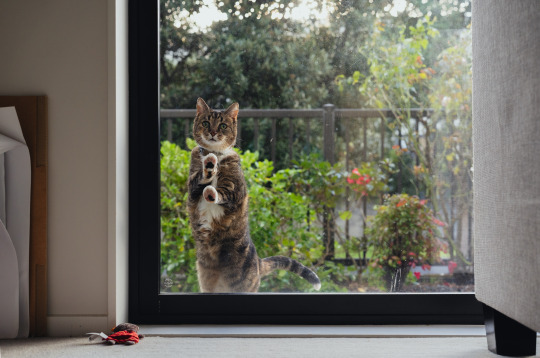

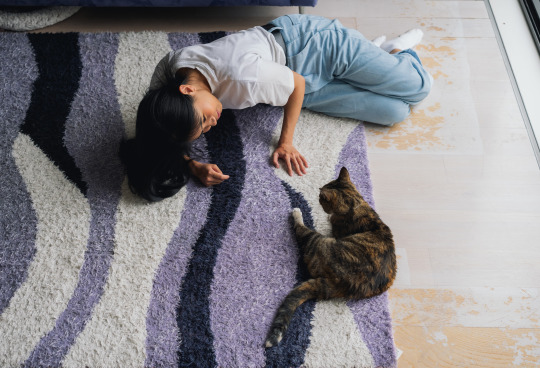
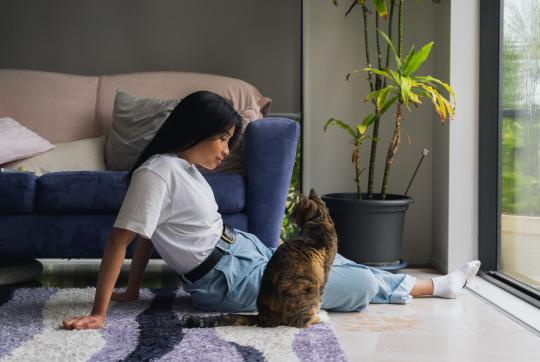
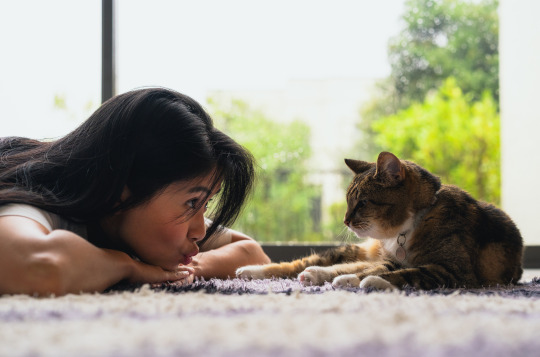
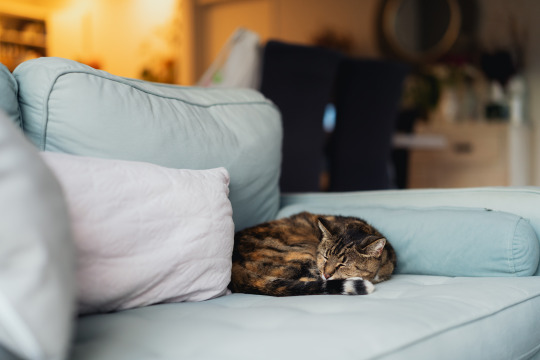
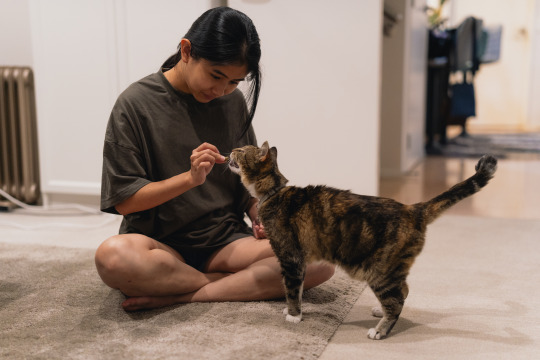

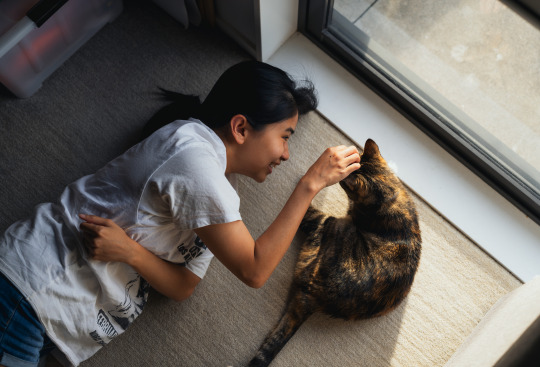

These are the final 15 images that I have decided to use for my photobook. Each one of these photos I have carefully selected, as I believe each one of them shows not only the personality of the subjects (Sellyna and Milly), but I also think there is some form of emotional bond and deep connection in these photos, especially the ones where Sellyna is interacting with Milly in various positions in different lighting condtions.
Along with these final images, because I was not in class in Week 11, I was not able to sort out an introductory assessment. Below is what I have planned on my introductory text in the photobook:
"This photobook is about my friend Sellyna and her cat named Milly. I got inspired from a photographer that I have admired for a long time named Hideaki Hamada. He is most famous for his photobook series on his children, Haru and Mina, where he takes images of them growing up over years. All of the images have a feeling of having a close and personal relationship, which in my life is something I take great importance in. I have tried to capture these feelings in these series of images that I have taken of Milly and Sellyna over the course of the semester. I decided to do a more documentary style approach, as I am more familiar with this style of photography, and I feel this style has a lot more raw feelings that I can get compared to other methods."
Varick Evangelista
As for my positioning statement, below is what I will be submitting as my positioning statement:
Positioning Statement
In my photobook for this class, my aim is to capture portraits of my friend Sellyna, along with her cat Milly. I wanted to capture them because they both share a deep, emotional connection with each other. They interact and are around each other so much, and so I thought this would be a great opportunity to showcase a deep connection with an animal through a series of images that would be taken throughout the semester.
When the class assignment was focused primarily on portraiture, I instantly knew where to look for inspiration. Hideaki Hamada is a photographer that I have been drawing inspiration for many years. His primary focus is on portraiture, particularly through taking pictures of his children throughout the years. His most famous work is through the collection of photos of his two children growing up, Haru and Mina. For me I love the way the documentary style of photography has. I feel that it has an essence of pure and raw emotions that different styles of photography can’t convey. It’s something that is found more commonly in Asian Photography.
As for the composition, I wanted to include close up shots, full body shots, along with capturing portraits that included the environment around it to give further context to the viewers who see this selection of photos. In terms of lighting, A common theme between all my photos is that all of them are taken next to, or near a window. This is because this technique is similar to what Hideaki Hamada uses in his photography, and looking at his pictures, it gives a really lovely bit of light over the subject.
I think for me, I tried to take these portraits in the way that convey the normal life that they live. In this case, my friend playing with her cat is something that she does every day, even without me having the camera to take the picture. I feel that if I left my subjects to do their own thing without asking them to do what I want them to do, the way they do things will feel a lot more natural and I also feel that the subject will feel more comfortable getting their photo taken, because I won’t be there interfering with what they want to do.
What I find interesting is how my approach to taking photos of Sellyna and Milly I've taken over the course of the semester has changed. Initially, I was very nervous on taking pictures of them, because of my fear of dealing with people. This is a very different way of photographing compared to what I was used to up until the start of the semester, which I normally focus more on street photography. I find that as I’ve gotten more confident, I haven’t been afraid to try different angles and not as afraid of telling them on small changes. I still however try and let them mostly do their own thing just to make it feel more natural through the photos I take of them.
I feel that one of the biggest improvements I’ve seen from my abilities throughout the semester is how the angle of light changes the way the final image looks and how post-processing is impacted through those changes. The workshops from the studio really helped me realise that and I feel that what I got taught there applies to natural lighting environments. For example,
Another big improvement that I have seen is in my ability to edit and post-process an image to make it look the way I envisioned it to be from my references. A lot of these reference images are Hideaki Hamada. This has been something I really struggled with for a very long time, as even though I would be happy with the final results initially, after a few hours, the image would look really bad and for a while I didn’t really know as to why it didn’t look similar. I think what made me improve is I changed the way I approach my editing from “How can I make it look like his” to “How can I make this image feel like his”. I feel that with the change of mindset, I really started to see my improvement. I compare my final edited image from earlier in the semester compared to now, and I can see that it’s a lot nicer to look at compared to the old one.
However, this idea was something that I did not originally start with. My original idea for this project was to capture portraits of people that I share a good connection with through my daily life. My original idea had included a series of images of a couple of people. These were my father and mother, along with the barista named Sam, who runs Kompass, a coffee shop opposite of the art gallery, Sellyna and her cat, and my baby cousin in which I have seen her grow from a small baby to a young child over the past six years. My reasoning as to why this idea did not go through was simply because I just did not have the time to dedicate a day to taking photos of each of these subjects. I realised late on the semester that it was better to focus on Sellyna and Milly, as not only did I have a lot of photos to choose from, it was also much more convenient for me to get a whole day dedicated to having a photoshoot of her and Milly.
I feel that with this class, I have gotten to really understand on the process of not only taking photos of people, but the process of how you get a certain look through the different ways of manipulating light to one’s advantage. I feel that for next semester for my next class, I will take the lessons I’ve learnt from this class and apply them to whatever I will take in that class. I feel that had I had more time in the semester to take more photos of different subjects, I felt that my vision would have been more seen through more images.
In this weeks class when presenting, I initially had an issue that I did not have time to fix, which was having the cover page separate from the rest of the book. This was fixed by the help of Natalie (our lecturer) through Adobe Acrobat, where there is a feature to combine PDFs into one. This solved the issues and makes it easier for both me (when I submit onto Canvas), and for Natalie (when it comes to marking).
0 notes
Text
Week 11 Photo




With the change of direction in terms of what I want to present and showcase for this assesment, I decided to go my friends house one more time to take one last photoshoot.
It was really good timing as well, since it was Kings Birthday on Monday, meaning I had three days where I could test out new photo ideas before my presentation on Thursday.
The three that I have highlighted are my favourites and ones ill be putting in the photobook.
For the first photo, the reason why I chose this as one of my favourites, along with wanting to put it in the photobook is because I felt that this was important to put it in because this is something Milly does very often. I also really like it because in front of her is the toy me and my friend use to entertain her, and before I took the shot we were using that toy. So I feel that having the toy lay in front of her adds a nice touch and adds that homey feeling of just being with your furry best friend.
For the second and third photos, I am planning on using these as part of the photobook with one next to each other when the book is fully opened. To achieve these two shots of Milly yelling to me for her to be let in, I had to use the burst setting on my camera. In my specific camera, it is able to do 10fps. This made it so it would make it a lot easier for me to capture that decisive moment of her expression along with her body language of her clawing against the glass door. I also kept in mind of keeping everything symmetical and straight. This includes lines for the door and the sofa. Because the lens I use has quite a bit of distortion in it's design, I had to correct it in Lightroom Classic to get it straight.
As for the photo of my friend with Milly, this was when they just woke up. I happen to have my camera with me so I took the picture when she decided to kiss her from above. I felt that it was very intimate and I felt with a close up shot like I did, it would being a level of intimacy and bond to the viewers.
Overall I feel that the way I have composed my images, along with knowing how different angles on where the light is coming from affects the final image, has definitely made me become a better photographer. I also feel that I have more confidence when it comes to taking photos of people.
0 notes
Text
Week 11 Task:
Unfortunately I was not able to come into class this week because I really needed to be with my team for my graduate class. Even though I wasn't able to be in class this week, I took the time to try and do the class task at home when I got the time to do it.
I've decided to try and use Lightroom Book again. I am familiar with the software and how you create a photobook out of it. It's built into Lightroom Classic and it's relatively simple to use and export. The only aspect of using Lightroom Classic Book that I don't enjoy using is that the cover page is seperated from the other pages. This means that it's exported as two files, rather than one combined file.
0 notes
Text
Week 10 Images




Sadly I wasn't able to do what I wanted from what I discussed on Week 10. This is still due to my graduate class taking priority. I still got the time to get some general shots throughout the week, along with getting shots of coffee for my other assignement, in which I take my own photos and use it in my magazine about coffee.
My personal favourite photo is the one I took of the sky and moon with the bus road of Panmure Station on the lower 1/3rd. I love the way the sky looked with its gorgeous purple/pink hues. I tried to really highlight the amazing colours from what I saw with my own eyes in the image.
0 notes
Text
Week 9 Images:



I was not able to carry out my goal for this week, due to my graduate class taking priority. One of my other classes is me making a magazine about coffee, so I used the shots I got for the magazine as part of my SDL. Taking photos of both the people that run the cafes, along with coffee that they made for me.
I did however get some shots of one of my subjects that I wanted to capture as part of my assignment photobook. This is also my personal highlight from my SDL, which is the photo I took of Sam.
Sam runs the coffee shop called Kompass, a small coffee shop located on Kitchener Street across the entrance of the Auckland Art Gallery. I have been a regular customer there for three years and developed a close bond with not only Sam, but with most of the other staff members who work there.
I decided to take a shot of him in the middle of making the latte art for my coffee. I did this as his expression is one where he is very focused, along with wanting to get that decisive moment in the lattee art pose.
I crouched down and pointed my camera up to get the shot. I did this as I felt it offered a more unique Point of View, especially since I had only one focal length to work with (50mm).
Looking back at the image, I wish I could have stepped back a bit more as his elbows are chopped off which does make the image less of a standout that it otherwise could.
I will be adding this image, along with the image of Sam putting down the coffee onto the white table. I think this complements the portrait of him well when placed next to each other in the photobook.
0 notes
Text
Week 10 Task:
In class today, we looked at Conor Clarkes work and Joyce Campbells work and I decided to do research on both of them.
Conor Clarkes:
Aotearoa New Zealand-born photographer Conor Clarke is well-known for her conceptual and documentary-style images that challenge the way that nature and landscapes are portrayed. She was born in Auckland in 1982, attended Elam School of Fine Arts, and lived in Berlin for almost ten years before moving to Christchurch. Her work challenges idealised or possessive depictions of land and water, criticising colonial and Romantic traditions in landscape painting. Especially in pieces like As Far as the Eye Can Reach, Clarke frequently uses multisensory components like sound, braille, and touch to enhance the way viewers experience place. Her poetic and critical art challenges viewers to reconsider the visual languages that are employed to frame identity and the environment.
Joyce Campbell:
Joyce Campbell is an Auckland-based photographer and artist who was born in Wairoa, Aotearoa, New Zealand, in 1971. She also teaches at the University of Auckland's Elam School of Fine Arts as a senior lecturer.
Campbell investigates cultural and natural processes in his work, frequently in harsh or environmentally delicate settings. She captures everything from microbiological growth to glaciers and mountain sceneries using both contemporary digital and analogue processes as well as antique photographic techniques including daguerreotype, ambrotype, and cibachrome photograms.
I also looked at this page to get some inspiration for my final photoshoots that I will do between now and before the presentation on Week 12.
One thing that really caught my eye is in the 2017 dummy award for third place. Hannes Wiedemann who is a photographer based from Germany looks to have done a photobook of people with computer chips inside them. It's a somewhat uncomfortable viewing experience, but at the same time, I am very intrigued by these images. Here are some photos below that caught my eye:
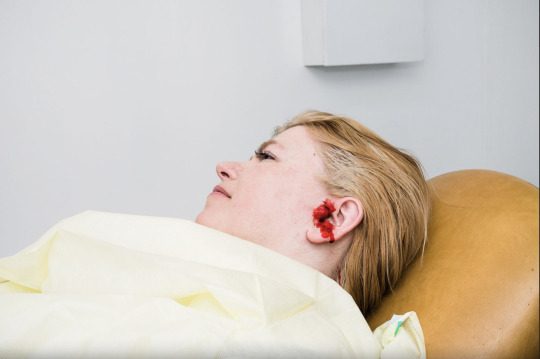
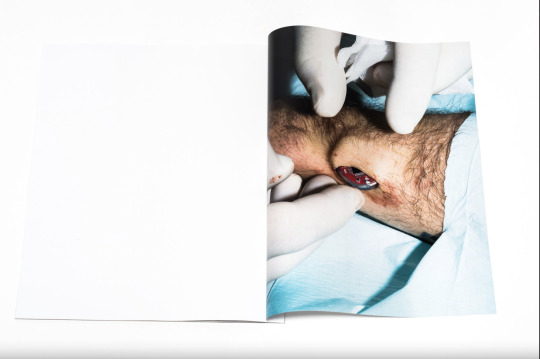
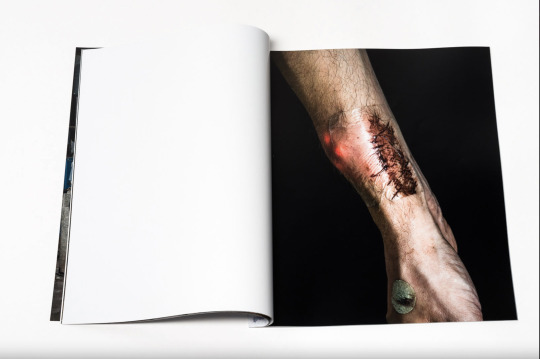
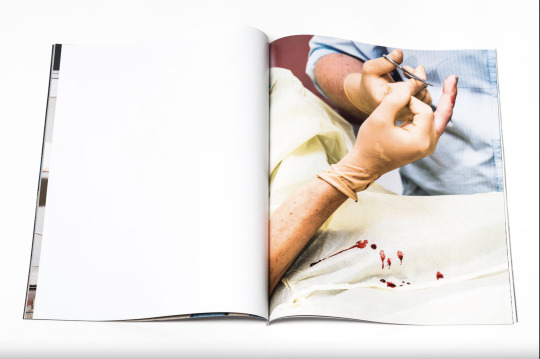
Because I have been so busy with my other classes, my idea of taking pictures of people who i have a close connection with that I interact on a daily basis is no longer feasible.
I took a long thought as to what I would do to try and get high quality storytelling without me having to sacrifice my other classes. This is when I remembered about the photobook Natalie talked about this week. I can't remember the name, but it was a photobook where it was a women in different natural spas around iceland, but the photos looked almost the same. Probably over 100 photos.
I got inspired from this book because whilst it might seem the same, the small changes between each image of her expression, pose and lighting can mean a lot of things. From my personal viewing, I see this as whilst it may seem like it's the same, small changes over a long period of time can result in a noticeable difference. I think for me that is how life is like.
I looked through the images I had taken and realised that I didn't need to take pictures of different subjects. It can also be one subject but with different compositions and lighting conditons to convery different feelings.
Because I already had a lot of sample images of Milly and my friend Sellyna, I decided that these two were gonna be my main subjects for the rest of the semester. My plan is to take more initimate photos of them together, along with taking photos of Milly with different expressions and actions throughout the shoot.
0 notes
Text
Week 9 Task:
What and who will you portray?
The people I want to potray are ones that I have a good connection with, and these people are ones that are a daily part of my life. These people that I will be photographing are my father, my baby cousin, Jayhuen from the cafe I go to everytime I go to Auckland CBD, and my friend with her cat.
What might you communicate visually through the concept of portrayal?
I think I would like to try and communicate visually the idea of a connection of showing emotion through the action of the portrait, mix of action and the environment they're in, and the emotions that the subjects show in those photos.
What is your position on your subject matter?
What is your voice? What is unique about your subject or your approach to it?
I think what is unique is that I would like to show a more raw and authentic view on my subjects with not a lot of distraction. I want the subject to clear for the audience to see.
What do you have unique access to? A group of people, a place, a situation…
Consider the important role the title takes in communicating your intention and how audiences might ‘read’ the book. What is your working title? What would you like readers to think and feel? What is the role of the text within the book? How does the text relate to the story the images tell? How do they work together? How many shoots do you require to gain adequate coverage and successfully tell the story? Do you need gear and support with your shoots? What is your plan? What software and workflow will you use to edit, process, collate and design your photobook PDF? What is your research plan? What other photobooks have you looked at? Are there decisions that have yet to be made? How will you resolve these?
For this upcoming weekend, I am planning on doing a photoshoot of either my father, or my baby cousin, depending on my availability of my dad.
This is a photographer that I have followed for a while. He is a thai speaking British photographer that does his photography in UK and Japan. He specialises in portrait photography with couples and families. I feel that his photos have a similar style and composition to what I wanna do in my photography. These are some photos that I would like to use as references to my personal photoshoots:

This one is one I have taken inspiration for my portrait of my dad. I like this one as it shows the environment that really helps viewers get an idea of who the person is without relying on their facial expressions.

This one I would like to use for as one of my image ideas for my baby cousin. This is because I feel for this example image, it's easy to see that there is a close bond between both the child and the parents. Both through facial expressions, along with the body language that is shown in this photo, which is of them both parents hugging the child.
0 notes
Text
Week 8 SDL:
The reason why I chose these pics for the final submission is because my dad isn't the most emotional person and I think for me, the way I would be able to for him to show some kind of emotion, along with showing some kind of emotion to the audience would be to do a portrait of my dad with my mother. Whilst my mother is no longer here physically, I still feel that she is still here with us and looking after as I continue on with life.
I decided to make my dad look at the Urn because I feel it would be a way to show the connection that is still there between my mother and my father, even if eight years have passed since her passing.
My Contact Sheet for Week 8:


0 notes
Text
Week 8 Task:
Unfortunately, I couldn't go to the Art Gallery with the class due to an emergency meeting with my Culinary Teachers on my graduate class. This is was something I could not miss out on.
Because I was unable to be in this weeks class, I decided to look up online of the exhibition that is being displayed in the Auckland Art Gallery of:
Marks Adams: A Survey | He Kohinga Whakaahua.
Link to Auckland Art Gallery Page of Mark Adams:
From what I've seen online in the Auckland Art Gallery website linked above, Mark Adams is a well-known New Zealand photographer whose 50-year career has focused on documenting the land, people, and layered histories of Aotearoa. His work captures culturally significant sites, including places visited by Captain Cook and locations tied to the signing of Te Tiriti o Waitangi. Adams has also explored Māori carving and Samoan tattoo traditions, reflecting a long-standing interest in cross-cultural artistic exchange. The exhibition Mark Adams: A Survey | He Kohinga Whakaahua presents over 65 works spanning his career, accompanied by a comprehensive book co-published with Massey University Press, available from April 3, 2025.


These photos from the website stand out to me because of what these people are wearing. It shows the traditional clothing of Maori people.
Because of his focus primarily on documenting the land, people and the history of Aotearoa, I find it fascinating seeing woven leaves used as the floor in the left picture, as well the environment in which the picture has been taken.
One thing I have noticed on the left image is that a flash has been used to brighten up the image indoors, whilst still maintaining the highlights outside of the window. The biggest clues to flash being used is the strong white light on the top right of the old CRT TV, along with another bright white light that is reflected from the right key that is hanging on the right side of the middle window above.
0 notes
Text
Week 7 Task:
Template for a photographic campaign
CONCEPT: Who do you want to photograph?
I want to photograph people that mean a lot to me and people that I interact on a daily basis that make my life better. What might link the group together?
What might link the groups of people together are a shared interest in formed relationship with them, whether they became a good friend, family member, or ones I look forward to seeing everytime I go to uni What do they have in common?
They are all people I connect with different apsects of my life. So family, friends and people that I have shared hobbies and interests in. What are potential strengths to the concept?
Sense of relatability, showcasing a part of my life to strangers or
What are the potential threats or weaknesses to the concept?
I know that not everyone is open to being photographed, which is completely understandable. In that case, I can always look for others that I have a special connection with.
Who are the group?
Dad
My Baby Cousin
Jaehyun from Kompass
My friend with her Cat
Overview:
What is the project?
This project is focused on portraits of people that I have some sort of good connection with and ones I interact with on a daily basis.
What is the objective?
My objective is showcase these people though the environement in which I interact with them, or to showcase them in a more documentary style.
Target audience?
I think the target audience is for people that have connection with others as an important part of their daily life.
Main message communicated?
Locations for these shoots:
Kompass Coffee
At my House
At my friends house
0 notes
Text
14 Day Challenge (Semester Break)
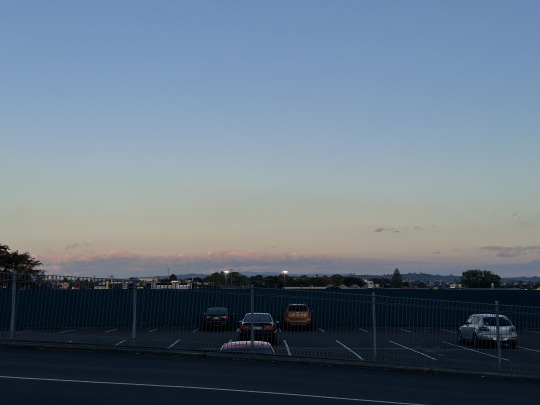















These are photos I took during the 14 days of the Semester Break. Unfortunately most of the days were spent working at my job, which prevents me from using my camera or me being able to have the time to take photos using my camera. I decided that I will use my phone during this period, as it would be much more convenient, as well as being able to take pictures in the meantime.
I believe using a smartphone can still provide some fantastic images, even if the phone relies heavily on post-processing.
My favourite photo out of all of these are photos of the cat withe clouds in the background. I love it because the cat is going around doing its own thing whilst walking around the fence with the beautiful clouds in the background. It also helps that it was a nice sunny day.
0 notes
Text
Week 6 Images:

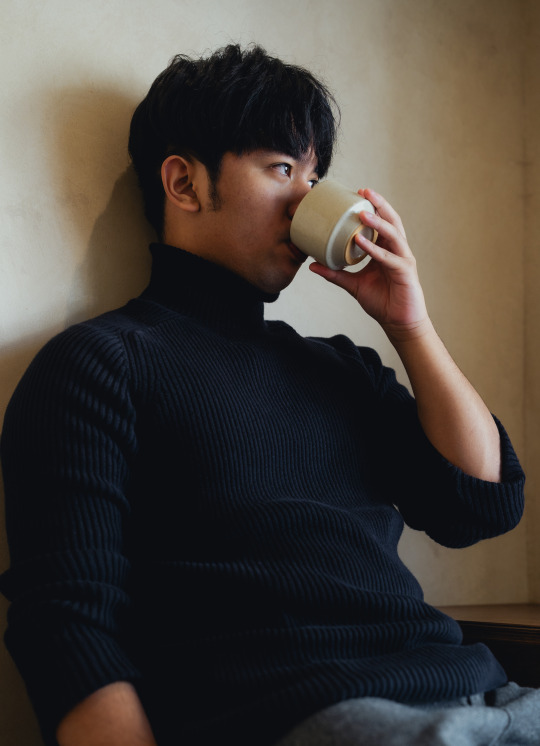
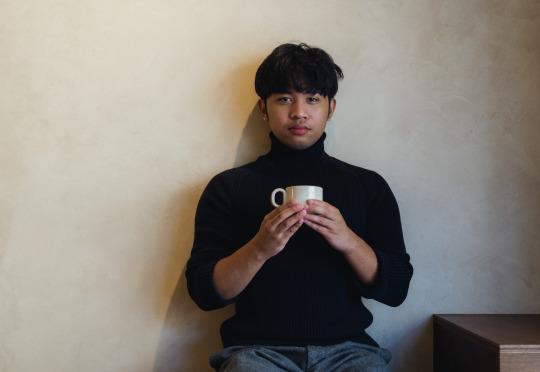
These will be my self-portraits used for the formative. Was hard to do with a not so stable tripod, but I made do with what I had available. I think I did alright, but taking photos of myself using a tripod was something I was not used to.
Now that I've taken portraits of myself, I can really get to understand what it's like being a model. It's not easy to be a model, especially out in public where other people can see you trying to create images of yourself.
STATMENT:
For my portraits, I first examined the places and connections that influence my daily life. I decided to choose a coffee shop for my self-portraits, as I have a strong bond with coffee shops, which I visit frequently in my leisure time during university. Coffee shops are, for me, spaces of calm and introspection where I can relax, have fun and have some time to myself. I want to convey in these pictures the private times of relaxation and seclusion that coffee shops offer.
As for the photos I took of my friend and her cat, I was trying to convey their special relationship and the intimate but peaceful times that they spend together. These pictures capture the nuanced yet potent interplay between them, celebrating the simplicity and depth of their relationship, through a close-up shot and full body shots.
Reflecting back on what I have captured so far, personally, it's a lot harder to do portrait photography than I initially thought. The hardest part of doing this assignment is trying to communicate the vision of what I wanna do through words to the model. Especially for the cat, it's hard to tell them what to do. I also found that taking photos of yourself definitely takes a lot of getting used to.
Below are the rest of the images I took this week before semester break:

0 notes
Text
Week 5 Images:
These are my top 3 images for this week. These will be used for the formative:

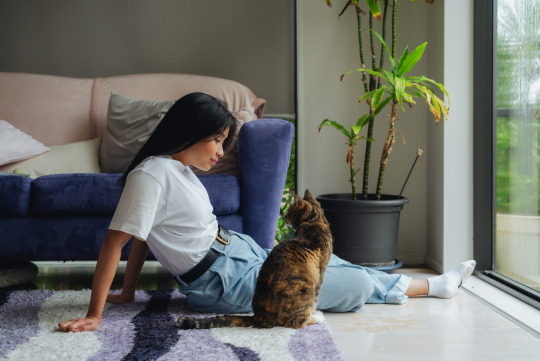

My roll of images for this week:


I came back again this weekend for another photoshoot. From shooting all weekend, I feel that these three images are for me the stand outs.
The first one I really like is because I feel that her expression is a playful expression and I feel when two subjects are laying on the ground and are in close proximity, I feel there is an added sense of closeness that comes with it. It's simple but I really love looking at it.
As for the second one, similar to the one I took the other week, where they were looking at each other, I like this photo for the same reason. Milly enjoys looking out of the window, especially during this shoot when it was raining, so I decided that my friend would sit next to her and watch the rain together.
The third one I did something similar to the other week, where I was on the sofa and pointed my camera on an angle to get a shot from higher up. I felt that this method showed the interaction between my friend and Milly more compared to if I was at eye level.
Similar to my other images, I keep in track on the lines in the images, such as the lines of walls and rug for example. It's a small detail, but one that I feel elevates the images overall.
For the reasons above, these will be on my formative photobook.
0 notes
Text
(Week 5) Task:
This week was me and my group trying to capture portraits in the studio using references that we chose online. We decided to do portraits similar to these two photos:


One was a more direct and harsh light towards the subjects face, whilst the other one of the famous portrait of Steve Jobs we tried using a more soft light to get the glow on the right side of the face, whilst maintaining the white background.
For the first photo (left), it took us a while to figure out the lighting and what we needed to do to achieve it. We started out by figuring out on how to achieve the pure white background. This was gonna be our key light. We figured out with the help of Cornelius that we would need 2 strong flashes that were synced together in order to achieve the desired background.
This is the result of setting up the key light:

Whilst the background is good, We also needed to figure out on how to get the subjects face lit up, as in the photo, it looks pretty dark. Me and the group figured out on how to get some light onto the subject's face, which we would need to achieve by adding white reflectors so that the light would bounce onto the face from the wall. These reflectors would be place on both sides right next to the subject whilst facing the wall.
This is what we got from adding the reflectors:

It looks a lot better, but me and the group understand that there are also factors that made the reference photo as it is compared to our attempt. These factors include possibly:
Makeup Artist
A well funded production team and equipment
Editing involved
Possibly a different lens
But we understood as well that whilst being able to recreate photos online is a good way to learn, we also needed to consider that we could never replicate the photo 100% without knowing what was being used in that specific photo. It would also be a benefit if me and the group figured out our own style of achieving a similar look to the reference.
As for replicating the Steve Jobs portrait, the key light stayed the same, as his portrait also has a white background. This will be used as our key light, so no need for changes there.
The challenge would be to try and get that light to hit the right side of the face, whilst also being able to maintain the shadow area and remove any of the bright white spots on the sides of the faces that was present on the last portrait.
We figured out that we would need to use the crane flash with a softbox to achieve the desired look. With some adjusting to the power of the flash, we managed to get this:

Me and my group were surprised to see this result and we very happy with it.
I believe this exercise has really opened a new interest in studio photography for me and I would like to use the studio after the break to improve my portraits for my final submission. Whilst natural light is great for certain portraits, it's a type of light that cannot be reliably used, especially when the weather changes as frequently as it does in Auckland.
0 notes
Text
Week 4 Images


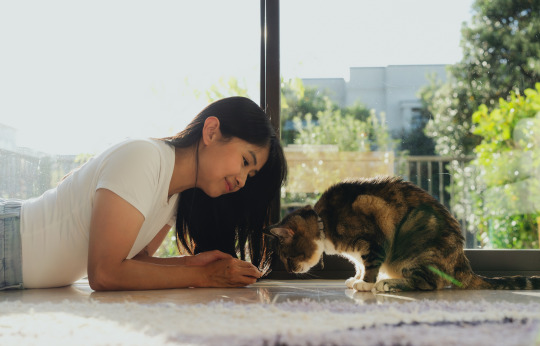

For this week, once again I went to Sellynas house to do another shoot of her and Milly. This time around, I really wanted to get a shot of her and Milly on the ground in front of the big sliding door window in the living room. I really wanted to try and capture an image from this area as it has a lot of light that comes in, along with having a lot more space to work around compared to the other room that was used in the previous two weeks' SDL.
I'm pretty happy with how the top three turned out, although I think I will come back for one more shoot, because I felt that I couldn't quite capture exactly what I wanted, which was for Milly to look at Sellyna in the eye whilst taking the snack away from her hand. It's to be expected, especially for a cat. But it was disappointing that I couldn't quite get the shot that I really wanted.
I am happy with the image of her sleeping on the sofa. It's simple and I feel this would be a great supporting image, because sleeping is of Millys favourite things to do throughout the day.
0 notes
Text
(Week 4) Task:
Anthony Byrt's article "Creation Myth" reviews the exhibition "Toi Tū Toi Ora: Contemporary Māori Art," which features a variety of modern Māori artwork. Byrt examines how the exhibition highlights the close ties to cultural heritage, identity, and history while showcasing the development of Māori artistic practices.
The article explores how the exhibition's artists confront modern concerns like colonialism, identity, and self-determination while also interacting with Māori traditions. Byrt challenges the viewer's perception of Māori culture and the function of art in modern society by highlighting how the pieces are not just manifestations of individual ingenuity but also act as a communal voice for the Māori community.
A complex story about the survival and resilience of Māori culture in the face of historical and present problems is reflected in the pieces' wide diversity, which includes sculpture, painting, photography, and installations, Byrt observes. Byrt claims that the exhibition, which combines traditional and contemporary expressions, is a potent message of continuity and change within Māori art.
In the end, the article emphasizes how Toi Tū Toi Ora is an essential investigation of modern Māori identity, giving Māori artists a stage on which to express their opinions and views in the larger art community.
0 notes
Text
Week Three Images:

Sadly I wasn't able to take that many pictures for this week, as I was focused on finishing assignments for my other two classes. I will be able to get back on track on the following week and continue to try and get shots of my friend for my formative assesment.
0 notes